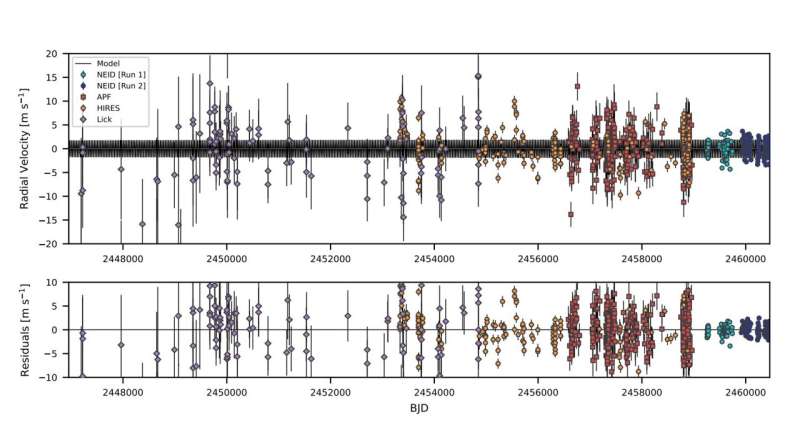September 26, 2024 report
This article has been reviewed according to Science X's editorial process and policies. Editors have highlighted the following attributes while ensuring the content's credibility:
fact-checked
preprint
trusted source
proofread
NEID Earth Twin Survey discovers its first alien world

An international team of astronomers reports the discovery of a new extrasolar world orbiting a nearby star known as HD 86728. This is the first exoplanet detection made as part of the NEID Earth Twin Survey (NETS). The finding was detailed in a research paper published September 18 on the pre-print server arXiv.
NEID is a fiber-fed, environmentally-stabilized optical-near-infrared echelle spectrograph installed on the WIYN1 3.5 m telescope at Kitt Peak National Observatory in Arizona. The NETS survey employs NEID to search for low-mass exoplanets around nearby bright stars.
Now, a team of astronomers led by Arvind F. Gupta of the U.S. National Science Foundation National Optical-Infrared Astronomy Research Laboratory in Tucson, Arizona, has identified the first exoplanet from NETS. The newfound planet orbits HD 86728—a bright star of spectral type G3Va, located some 48.6 light years away.
"In this work, we present the first three years of NETS observations of the HD 86728 system and we confirm the detection of the exoplanet HD 86728 b ... HD 86728 was observed with NEID on 137 separate nights during the first three years of the NETS program," the researchers wrote in the paper.
According to the study, the newfound exoplanet HD 86728 b orbits its host star on a circular orbit every 31.15 days, at a distance of about 0.19 AU. The projected mass of this planet was estimated to be some 9.16 Earth masses.
The astronomers noted that the vast majority of exoplanets with similar masses and orbital periods to HD 86728 b reside in multi-planet systems. Therefore, if it hosts only HD 86728 b, this planet would be in the small minority (less than 12 percent) with no known siblings. However, further observations are required in order to rule out the presence of additional planets orbiting HD 86728.
When it comes to the host star, HD 86728, it has a radius of approximately 1.24 solar radii, while its mass is comparable to that of the sun. The star has an effective temperature of about 5,610 K and its metallicity is at a level of 0.2 dex.
In concluding remarks, the authors of the paper underlined that the detection of HD 86728 b proves how important extreme precision radial velocity spectrographs are for the search for low-mass alien worlds.
"NEID and other extreme precision spectrographs will continue to chip away at the sensitivity floor for quiet stars, enabling the detection of exoplanets at lower masses and longer periods as we push towards the discovery of Earth analogs with radial velocity measurements," the scientists wrote.
More information: Arvind F. Gupta et al, The NEID Earth Twin Survey. I. Confirmation of a 31-day planet orbiting HD 86728, arXiv (2024). DOI: 10.48550/arxiv.2409.12315
Journal information: arXiv
© 2024 Science X Network





















